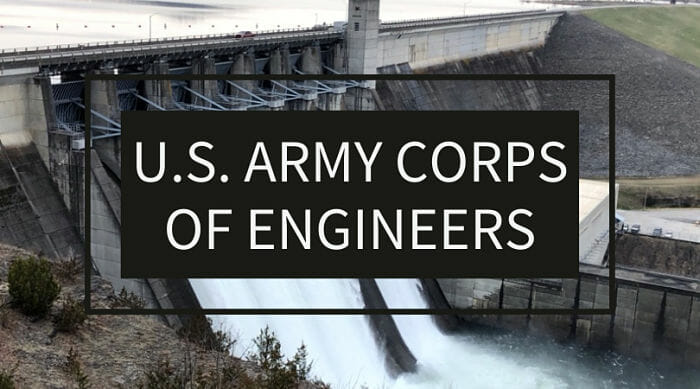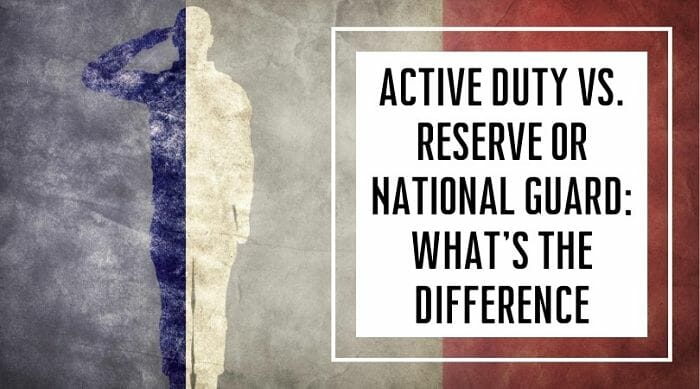U.S. Army Corps of Engineers (USACE)
Updated: April 22, 2021
The U.S. Corps of Engineers (USACE) is an important part of the nation’s military. The agency is responsible for a wide range of efforts in the United States including addressing safety issues related to waterways, dams, and canals but also environmental protection, emergency relief, hydroelectric power, and much more.
Americans are likely most familiar with the Corps Of Engineers for its role in the 2020 response to COVID-19 and the coronavirus epidemic. The Corps of Engineers most visibly worked with New York Governor Andrew Cuomo to build hospital facilities and screening zones, but the agency has also been involved in natural disasters, responding to the terror attacks of 9/11, and other notable events.
USACE is mainly a civilian operation; the official site for the agency says there are some 32,000 employees and that they are “primarily civilian.”
What Is The Army Corps Of Engineers?
USACE is a federal public engineering, design, and management agency under DoD jurisdiction. Its primary mission is related to flood protection, canals, and dams, but it also undertakes public works projects outside the United States.
USACE is a major Army command tasked with responsibility over the following areas:
- Designing, building, and operating locks and dams
- Flood control
- Dredging waterways
- Building flood protection systems
- Design and construction management for the U.S. military and government agencies
- Environmental regulation
- Ecosystem restoration
The U.S. Army Corps of Engineers is organized into eight regions in the United States. There are also provisional organizations including a provisional region and a provisional district. The eight permanent regions include:
- Great Lakes and Ohio River Division in Cincinnati.
- Mississippi Valley Division in Vicksburg, Mississippi
- North Atlantic Division at Fort Hamilton in Brooklyn, New York
- Northwestern Division in Portland, Oregon
- Pacific Ocean Division at Fort Shafter, Hawaii
- South Atlantic Division in Atlanta
- South Pacific Division in San Francisco
- Southwestern Division in Dallas
There is also a Transatlantic Division in Winchester, Virginia, which supports federal programs overseas.
A Brief History of the U.S. Army Corps Of Engineers
The earliest organization of Army engineers dates all the way back to 1775, and Army engineers have served on the front lines for all American conflicts ever since. But it would be another few years until the Army established the Corps of Engineers in a formal capacity.
On March 16, 1802, the Corps of Engineers became a separate and permanent part of military service; at the same time in history these engineers were tasked with building West Point, the Army’s four-year federal service academy.
The Army Corps of Engineers’ motto is “ESSAYONS” which is a French phrase meaning “Let us try.” This is a nod French engineers who aided the Americans during the Revolutionary War.
Public Works And Mission Readiness
The Corps Of Engineers meets a need to have military construction, waterway management, disaster recovery, and expertise in these areas simultaneously with a public works-type vision supplementing mission-readiness and adding a humanitarian aspect to the mission of USACE.
From the earliest days of the Corps, public works projects and readiness went hand-in-hand. USACE mapped the western lands of early America, build lighthouses, explored and mapped waterways, and much more.
Floods, Earthquakes, And USACE
By the time America left the 1800s behind and moved into the 20th century, USACE had gained considerable expertise in flood control, and America grew to lean more heavily on the Corps of Engineers for disaster relief.
USACE responded to the call for help during the Mississippi Flood of 1882, making that incident the first natural disaster relief mission where USACE resources were used. Other incidents in and around this time that brought out the Corps of Engineers out to assist include an 1889 flood in Johnstown, Pennsylvania, and the San Francisco earthquake of 1906.
World War Two And Beyond
With the advent of World War Two, the Corps of Engineers found itself busy at home and abroad, but they were also instrumental in projects during the Cold War including work in Saudia Arabia, participation in NASA projects, and even working with the United States Postal Service.
Post-WW2, the Corps of Engineers would respond to major emergencies including recovery from a blizzard on the Great Plains, a massive ship explosion in Texas, and others. In 1950 the U.S. government knew it had an important resource in USACE; the Federal Disaster Relief Act of 1950 insured that the Corps would be used as a leading federal agency for flood recovery.
In the 1960s, a growing awareness of environmental issues led to a variety of public and private efforts to promote conservation and protection of natural resources. The 1960s were not only the decade that saw the creation of Earth Day by Senator Gaylord Nelson in 1969; it was also the decade the U.S. Army Corps Of Engineers was led to become a major environmental protection force in the federal government ecosystem.
The 1980s And Beyond
The work of the Corps expanded in the 80s. Floods have always been a part of the USACE mission but other emergencies led officials to create an emergency management program.
Thanks to legislative action in 1988 (the Robert T. Stafford Disaster Relief and Emergency Assistance Act) authorized the Federal Emergency Management Agency to provide for all disasters, regardless of cause. USACE works with FEMA in this expanded capacity to provide assistance for floods, earthquakes, volcano activity, etc.
1989 proved to be a challenging time for USACE; the Exxon Valdez oil spill occurred when the Exxon Valdez spilled more than ten million gallons of crude oil into Price William Sound, Alaska–said to be the worst oil spill in U.S. history up to that time. (“Worst Ever” honors would fall to the Deepwater Horizon oil spill off the coast of Louisiana in 2010.)
USACE involvement in the Exxon Valdez spill, which was blamed on the ship’s captain, Joseph Hazelwood, (said to have been under the influence of alcohol at the time) would last until 1992. And the 90s were filled with other disasters that would require the Corps to answer the call:
- Hurricane Andrew
- Hurricane Iniki
- Mississippi River flooding
- Missouri flooding
- Northridge California earthquake
In the 21st Century, Army engineers were instrumental in a variety of efforts including recovery from 9/11, supporting overseas operations associated with the war on terrorism, and reconstruction efforts in areas affected by U.S. operations in Afghanistan and Iraq.
The Corps of Engineers responds to a wide variety of needs in the 21st Century. The most highly visible contemporary version of USACE’s ability to respond is its role in the coronavirus pandemic of 2020; the agency is involved in efforts to build treatment facilities and screening locations for potential coronavirus patients.
How To Join The Army Corps Of Engineers
There are active efforts to hire new employees for USACE. The jobs available are listed on the federal government’s hiring site, USAJobs.gov.
Those hired by the agency may be offered education benefits, professional and leadership development, continuing education, and mentoring programs. Civilian career options in USACE include the following career field codes and job titles:
- 0408, Ecology
- 0482, Fish Biology
- 0486, Wildlife Biology
- 0025, Park Ranger
- 0401, Biologists
- 0401, Natural Resources Specialists
- 0802, Engineering Technician
- 0808, Architects
- 0809, Construction Control Technician/Representatives
- 0810, Civil Engineers
- 0817, Survey Technician
- 0819, Environmental Engineers
- 0830, Mechanical Engineers
- 0850, Electrical Engineers
- 1102, Contracting Specialist
- 1170, Realty Specialists
- 5426, Lock and Dam Operators
The USACE official site advises job seekers to go to USAJOBS, search for jobs there, and apply by agency, job description, or location. Applicants must have a current resume in USAJOBS before applying.
Army Corps of Engineers Campgrounds & Outdoor Recreation Areas
USACE provides access to campgrounds and outdoor recreation at more than 400 lake and river projects in 43 states. Access to the recreation is open to everybody. Free or discounted access is available to active duty military, disabled veterans, retired military, seniors and others.
Activities For All Ages Include:
- Bike Trails
- Boating
- Camping
- Equestrian Trails
- Fishing
- Golf
- Hiking Trails
- Hunting
- Interpretation
- Paddling
- ORV Trails
- Swimming
- Snorkeling
- Windsurfing
- Whitewater Rafting
- Geocaching
Find a USACE Outdoor Recreation area near you.
 Joe Wallace is a 13-year veteran of the United States Air Force and a former reporter for Air Force Television News
Joe Wallace is a 13-year veteran of the United States Air Force and a former reporter for Air Force Television News
Most Popular Military Careers Articles

FBI Agent vs. CIA Officer: What’s the Difference?

Space Force Careers

How to Become a Military Doctor































































